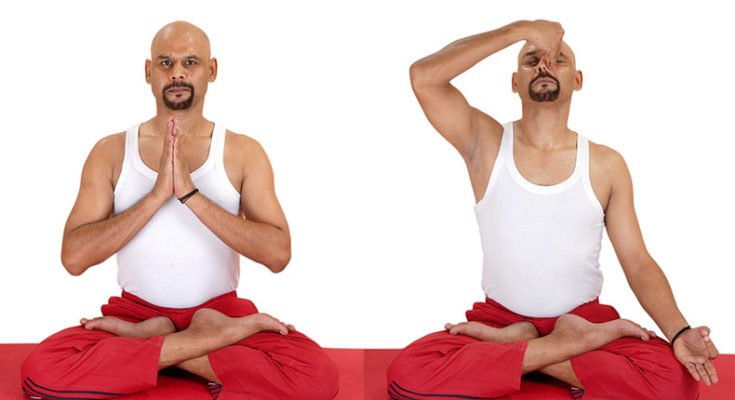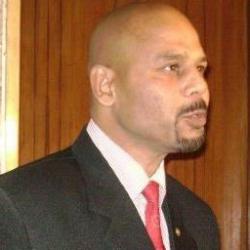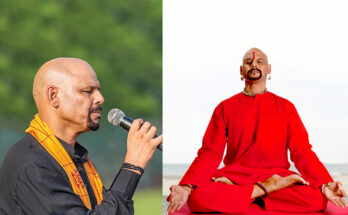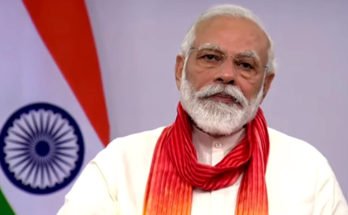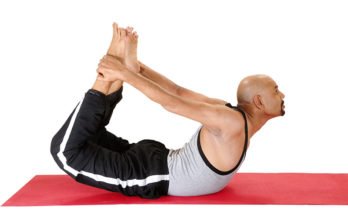Hatha Yoga is demonstrated by Yogaguru Suneel Singh – one of the top ranked yoga gurus of the world. Image Courtesy – Vijay Gautam.
Yoga is a complete science of health, which deals with the understanding of the adequate functioning of all systems of our body and appropriate coordination between them along with the healthy functioning of our mind. Yoga is derived from the ‘Sanskrit Dhatoo’ “Yuj” which means to join or bind or, to attach. It also means “to direct and to concentrate on a particular point of thought to works in full attention of mind and body.”
Yoga is based on our ancient ‘wisdom’ and ‘culture’, which is more than 6000 years old and has been referred to two specific words. One is “Sanatan” – which means eternal as the process of evolution. And the other is “Puratan” – which means very ancient. Yoga is found in the ancient books like ‘the Vedas’, ‘the Gita’, ‘the Upanishads’ and ‘the Patanjali Yoga Sutra’.
Yoga is a fully developed science based on the deep inner study of human body and intense self-experiments and practices of our ancient saints. Since yoga developed in India, it has got association with Hinduism and its philosophy. But, yoga is independent of any religious doctrines or dogmas. Yoga does not discriminate any person or belief. It is a way of thinking, doing things and following. Yoga is science as well as an art of healthy living. Yoga means holistic approach towards the cause and treatment of disease.
Read: Achieve total health with 12 rounds of Sun Salutation
Yoga arose at the beginning of human civilization when man first realized his spiritual potential and began to evolve techniques to develop it. According to mythical tradition, ‘Lord Shiva’ said to be the founder of yoga and his wife ‘Parvati’, being his first disciple. The yogic science was slowly evolved and developed by ancient sages in India. Yoga is in no way limited by race, ages, religion or creed.
Many types of Yoga:
There are many types of yoga, though nine are considered principal depending upon which school of thought they come from. These are – (1) Sahaj Yoga, (2) Mantra Yoga, (3) Raj Yoga, (4) Hatya Yoga, (5) Laya Yoga, (6) Dhyan Yoga, (7) Jyana Yoga, (8) Bhakti Yoga and (9) Karma Yoga.
In the past, people were not so much interested in material objects, but quest led them to go beyond the matter. A certain part of their life was spent in understanding the issues for the ultimate knowledge of the universe. People and the spirit were in the search for the unlimited knowledge. The ultimate goal of the yoga is the same; though the paths or methods prescribed by each may be different. Yoga is a process of conscious upholding of oneself where by the physical, mental and spiritual nature of the individual attains “its perfect development and the totality of the whole life”. Yoga is a process of realization.
It was ‘Rishi Patanjali’ who was rightly called the father of ‘Astanga Yoga’. Patanjali, in his treatise on yoga (the yoga sutra) has mentioned all the eight limbs or constituents were to be present in the same sequence to make the process of yoga successful. The classic yoga, commonly known as the ‘Ashtanga Yoga’, covers both the yoga ideology and technology.
The first five deals with training the body and last three teach the perfection to you:
(i) Yama – Code of conduct both personal and social in society.
(ii) Niyama – Self discipline.
(iii) Asana – Postures.
(iv) Pranayama – Breathe control or bio-energy control.
(v) Pratyahara – Withdrawal or abstraction.
(vi) Dharna – Concentration.
(vii) Dhyan – Meditation.
(viii) Samadhi – Super consciousness.
Of these, the first five called as ‘Bahiranga Yoga’ or ‘Hatya Yoga’ while the latter three called as ‘Antranga Yoga’ or ‘Raja Yoga’.
Read: Yoga reduces emotional & nervous tension
Yama:
In ‘Hatya Yoga’, yama is comprises of five ethical disciplines of self-restraint – (1) Ahinsa (non violence), (2) Satya (truth), (3) Brahmacharya (continence), (4) Asteya (non stealing), (5) Aparigraha (non hoarding).
Niyama:
Niyama are the five regulations governing personal behaviour or self-discipline – (1) Saucha (purity), (2) Santosha (continents), (3) Tapas (austerity), (4) Swadhaya (self study), (6) Ishwar pranidhan (dedication to the god).
Asana:
Asanas are well described in ‘Hath Yoga Pradipika’ – “The posture in which one can sit for indefinite period comfortably is called asana”. Patanjali says, “Sthir, sukhasa am” – which means the posture in which we can sit comfortable and steadily is called asana.
Literally, asana means “posture of the body which can contributes to the steadiness of body and mind and a sense of well-being. The asana can be defined as a postural pattern one has to achieve this pattern slowly, maintaining the posture steadily for some time and then slowly release the posture. There are two aspects involved in asanas – (1) Dynamic aspect and (2) Static aspect.
Asanas are classified in three categories (1) Meditative asanas (2) Asanas for mental tranquillity (3) Asanas providing physical strength.
Ever asana consists of three stages that are coming in to the prescribed pose, holding it and then finishing it. They should be performed slowly steadily with patience. Different schools of yoga have mentioned different yogic postures, which are common with 84 asanas.
Asana make the body disease free, strong and flexible by regulating glandular secretions, toning muscles and nerves; Asanas helps a practitioner getting freedom from physical disabilities and mental distractions.
Read: Enhance your sexual life with yoga
Pranayama:
The word ‘pranayama’ is formed by two words ‘Prana’ and ‘Ayama’. ‘Prana’ means subtle life force and ‘ayama’ is voluntary effort to control and direct this prana. ‘Pranayama’ means control of the motions of exhalation and inhalation.
Stiffness of the body due to blocked ‘prana’ and a subsequent accumulation of toxins when ‘prana’ begins to move or flow; the toxins are removed from the system ensuring the health of whole body. And when the quantum of ‘prana’ is increased in great degree the body moves in to certain postures by itself and ‘asanas’ and ‘pranayama’ occur spontaneously. The main object of ‘Hata Yoga’ is to create balance between the interacting activities and processes of the pranic and mental forces. ‘Pran’, it is known as ‘Chi’ in china ‘Ki’ in Japan and ‘spirit’ in the Christian world. Generally, it is said that breathing or respiration is the most vital process that provides the body the necessary oxygen and vital energy from the air.
Four Aspects of Pranayama:
(1) Pooraka (or inhalation)
(2) Rechaka (exhalation)
(3) Antar kumbakha (international breath retention)
(4) Bahya kumbak (external breath retention)
Though there are numerous types of pranayama, but commonly known are (1) Surya Bhedi Pranayama (2) Ujjayi Pranayama (3) Shitkari Pranayma (4) Shitali Prayanama (5) Bhastrika Pranayama (6) Bharmari Pranayama (7) Murcha Pranayama (8) Palavani Pranayama.
‘Pratyahara’, ‘shat karma’, ‘mudras’, and ‘bandhas’ are also the part of ‘Hatya Yoga’. The practice of ‘Hatya Yoga’ is done in combination with ‘asana’ and ‘pranyama’. Pranayama makes us aware of our breathings so that we can activate and regulate the vital life force in our body.
Pranayama influence the flow of ‘prana’ in the ‘nadis’, thus purifying, regulating and activating them there by inducing physical and mental stability. According to ‘Hata Yoga Pradipika’ in one cycle of ‘prana’, there are proportions like 1:4:2: for inhalation, retention and exhalation respectively.
Hath yoga is the universal religion of man irrespective of his political, religious, or social status. It has more preventive than curative values. ‘Hath Yoga’ provides the best way of servicing the body and mind.

